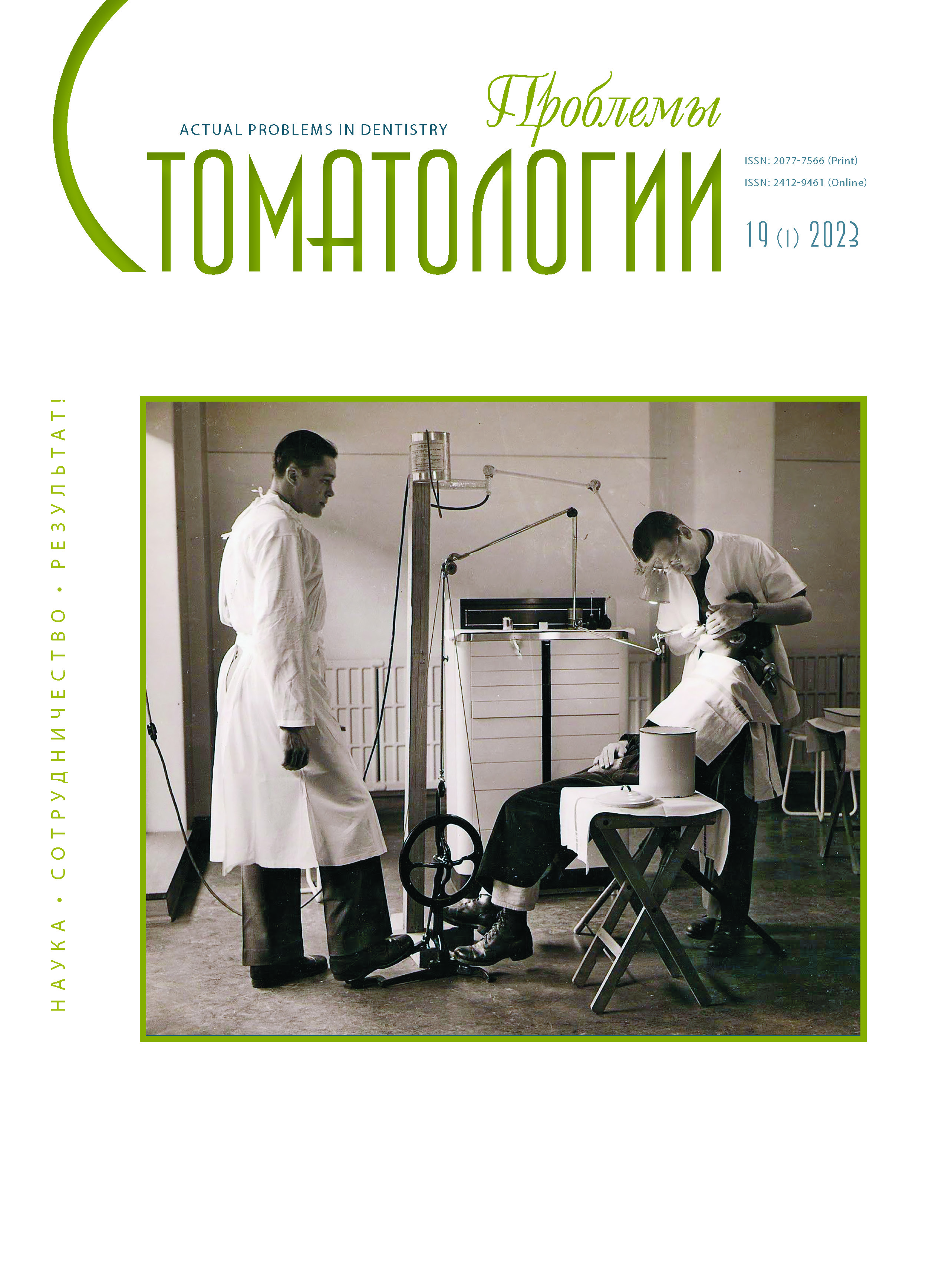Tyumen', Russian Federation
Tyumen, Tyumen, Russian Federation
Tyumen, Tyumen, Russian Federation
Tyumen, Tyumen, Russian Federation
UDC 616
Objectives. To determine the prevalence and severity of alexithymia in patients with oral manifestation of lichen planus (LP). Methodology. The study involved 90 young and middle-aged patients (mean age 49.4 ± 8.9 years). The patients were divided into 3 groups: group 1 – 34 people with oral manifestations of LP, group 2 – 16 people with leukoplakia, group 3 – 40 people without clinical manifestations of diseases of the oral mucosa. A dental examination was conducted, including an assessment of the condition of the oral mucosa, and a standardized questionnaire survey using a Russian-language validated version of the 20-point Toronto Alexithymia Scale. Results. Alexithymia was detected in 55.88% with various forms of LP, which is statistically 2.2 times higher (p < 0.001) than in patients with leukoplakia of the oral mucosa (25%) and 5.6 times higher (p < 0.001) than in patients of group 3 who do not have diseases of the oral mucosa. The average score of alexithymia in patients with LP was 80.5 ± 2.7 points, which is statistically significantly higher than in the group of patients with leukoplakia (61.0 ± 4.2 points, p = 0.006) and in the control group (44.1 ± 2.9 points, p < 0.001). A higher incidence of alexithymia was revealed in patients with exudative hyperemic form (58.33%, P1 = 0.041) and erosive-ulcerative form of LP (57.14%, p = 0.049). Quantitative assessment of alexithymia showed that among patients with LP, the greatest severity of alexithymia was found in patients with exudative hyperemic form of LP – 85.9 = 1.5 points, (p < 0.001). Conclusion. The data obtained allow us to consider LP as a disease in the development of which there is a psychosomatic component. The presence of alexithymia and the degree of its severity can be considered as a predictive or predictive candidate factor.
diseases of the oral mucosa, lichen planus, psychological properties of personality, alexithymia, psychosomatic pathology
1. Anan'ev V.A. Osnovy psihologii zdorov'ya. Kniga 1. Konceptual'nye osnovy psihologii zdorov'ya. Spb. : Rech'. 2006:384. [V.A. Ananyev. Fundamentals of health psychology. Book 1. Conceptual foundations of health psychology. St. Petersburg : Speech. 2006:384. (In Russ.)]. https://www.studmed.ru/ananev-va-osnovy-psihologii-zdorovya-kniga-1_d8929095b3e.html
2. Vil'danov M.N., Gerasimova L.P., Chemikosova T.S. Ocenka korrelyacionnoy svyazi mezhdu psihoemocional'nym sostoyaniem i bolevym faktorom u pacientov s krasnym ploskim lishaem rta. Problemy stomatologii. 2022;18(3):77-81. [M.N. Vildanov, L.P. Gerasimova, T.S. Chemikosova. Evaluation of the correlation between the psychoemotional state and the pain factor in patients with lichen planus of the mouth. Actual problems in dentistry. 2022;18(3):77-81. (In Russ.)]. https://doi.org/10.18481/2077-7566-2022-18-3-77-81
3. Gorodilova E.A., Gileva O.S., Koshkin S.V., Halyavina I.N. Mezhdisciplinarnye podhody k kompleksnomu lecheniyu bol'nyh s rasprostranennym krasnym ploskim lishaem kozhi i slizistoy obolochki rta: rol' proteticheskogo lecheniya. Vyatskiy medicinskiy vestnik. 2016;77(1):20-26. [E.A. Gorodilova, O.S. Gileva, S.V. Koshkin, I.N. Khalyavina. Iterdisciplinary approaches to comprehensive treatment of patients with generalized lichen planus of derma and oral mucosa: the role of prosthetic treatment. Vyatka Medical Bulletin. 2016;77(1):20-26. (In Russ.)]. Https://cyberleninka.ru/article/n/mezhdistsiplinarnye-podhody-k-kompleksnomu-lecheniyu-bolnyh-s-rasprostranennym-krasnym-ploskim-lishaem-kozhi-i-slizistoy-obolochki-rta/viewer
4. Grigor'ev S.S., Zhovtyak P.B., Letaeva O.V. Krasnyy ploskiy lishay slizistoy obolochki rta. Obzor literatury. Ural'skiy medicinskiy zhurnal. 2014;5(119):8. [S.S. Grigoriev, P.B. Zhevtyak, O.V. Letyaeva. Lichen planus of the oral mucosa. Literature review. Ural Medical Journal. 2014;5(119):8. (In Russ.)]. https://www.elibrary.ru/item.asp?id=21982436
5. Kolpakova N.V., Shestel' A.I. Rasprostranennost' aleksitimii sredi studentov medicinskogo vuza. Vzaimosvyaz' s somaticheskoy zabolevaemost'yu, nalichiem vrednyh privychek i urovnem uspevaemosti. Medicinskaya nauka i obrazovanie Urala. 2021;22(2):128-131. [N.V. Kolpakova, A.I. Shestel. The prevalence of alexithymia among medical university students. The relationship with somatic morbidity, the presence of bad habits and the level of academic performance. Medical science and education of the Urals. 2021;22(2):128-131. (In Russ.)]. https://doi.org/10.36361/1814-8999-2021-22-2-128-131.
6. Starostina E.G., TeylorGrem Dzh, Kvilti L.K., Bobrov A.E., i dr. Torontskaya shkala aleksitimii (20 punktov): validizaciya russkoyazychnoy versii na vyborke terapevticheskih bol'nyh. Social'naya i klinicheskaya psihiatriya. 2010;4. [E.G. Starostina, J. Taylor Graham, L.K. Kilty, A.E. Bobrov et al. Toronto scale of alexithymia (20 points): validation of the Russian-language version on a sample of therapeutic patients. Social and clinical psychiatry. 2010;4. (In Russ.)]. https://cyberleninka.ru/article/n/torontskaya-shkala-aleksitimii-20-punktov-validizatsiya-russkoyazychnoy-versii-na-vyborke-terapevticheskih-bolnyh
7. Dun-Yu H., Wu-Chien C., Chi-Hsiang C., Kuo-Chou C., Tsung-I L., Ling-Yu K., Nian-Sheng T. Risk of anxiety and depression in patients with lichen planus: A nationwide population-based study. 2022. https://doi.org/10.1016/j.jad.2021.12.127
8. Friedrich R.E. et al. Oral lichen planus in patiens with chronic liver diseases // Infection. - 2013;31(6):383-386. https://doi.org/10.1007/s15010-003-4074-5
9. Gazhva S.I., Stepanyan T.B., Goryacheva T.P. The prevalence of dental diseases of the oral mucosa and their diagnosis // International Journal of Applied and Fundamental Research. - 2022;5-1:41-44. https://doi.org/10.21638/spbu11.2022.305
10. Manolache L., Seceleanu-Petrescu D., Benea V. Lichen planus patients and stressful events // J Eur Acad Dermatol Venereol. - 2018:437. DOIhttps://doi.org/10.1111/j.1468-3083.2007.02458.x
11. Monica G., Bruno F., Ivan B., Luiz Antônio G., Denis N., Janet D. Emotional assessment of patients with oral lichen planus // Int J Dermatol. - 2015;29:32. DOIhttps://doi.org/10.1111/ijd.12052
12. Saad A., Lorena B. Psychological screening test results for stress, depression, and anxiety are variably associated with clinical severity of recurrent aphthous stomatitis and oral lichen planus // J. Evid Based Dent Pract. - 2014;14(4):206-208. DOIhttps://doi.org/10.1016/j.jebdp.2014.10.004
13. Salakhov A.K., Ksembaev S.S., Baikeev R.F., Silagadze E.M. Dental morbidity of the population of Russia // Kazan medical journal. - 2020;101(5):713718. https://doi:https://doi.org/10.17816/KMJ2020-713.
14. Sang H., In-Kyung S., Jeong H., Sun-Young L., Hyun P., Chan S. The effect of emotional stress and depression on the prevalence of digestive diseases // Neurogastroenterol Motil. - 2015;30;21(2):273-282. https://doi:https://doi.org/10.5056/jnm14116
15. Sifneos P.E. The prevalence of «alexithymic» characteristics in psychosomatic patients // Psychotherapy and Psychosomatics. - 2017:255-262. DOI:https://doi.org/10.1159/000286529
16. Parlatescu I., Tovaru M., Nicolae C.L., Sfeatcu R., Didilescu A.C. Oral health-related quality of life in different clinical forms of oral lichen planus // Clin Oral Investig. - 2019;17. doi:https://doi.org/10.1007/s00784-019-02951 -8.
17. Wiriyakijja P., Porter S., Fedele S., Hodgson T., McMillan R., Shephard M., Ni Riordain R. Validation of the HADS and PSS-10 and psychological status in patients with oral lichen planus // Oral Diseases. - 2020;26(1):96-110. https://doi.org/10.1111/odi.13220



















